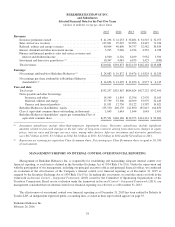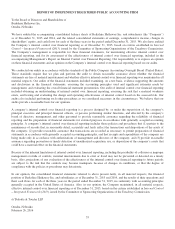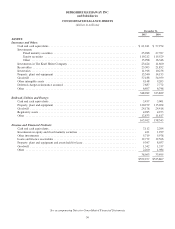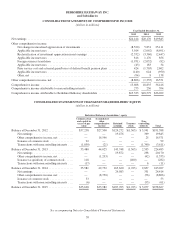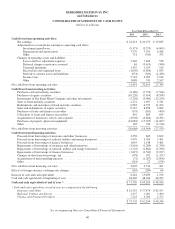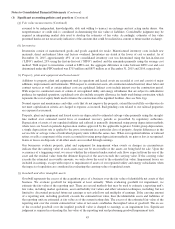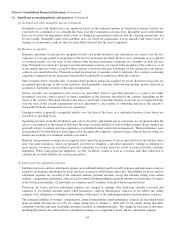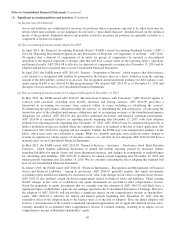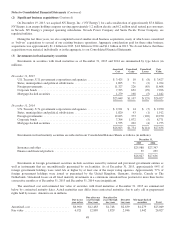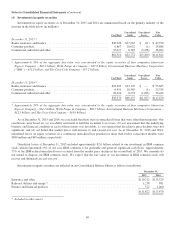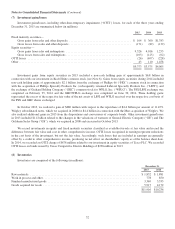Berkshire Hathaway 2015 Annual Report Download - page 45
Download and view the complete annual report
Please find page 45 of the 2015 Berkshire Hathaway annual report below. You can navigate through the pages in the report by either clicking on the pages listed below, or by using the keyword search tool below to find specific information within the annual report.Notes to Consolidated Financial Statements (Continued)
(1) Significant accounting policies and practices (Continued)
(g) Fair value measurements (Continued)
assumed to be independent, knowledgeable, able and willing to transact an exchange and not acting under duress. Our
nonperformance or credit risk is considered in determining the fair value of liabilities. Considerable judgment may be
required in interpreting market data used to develop the estimates of fair value. Accordingly, estimates of fair value
presented herein are not necessarily indicative of the amounts that could be realized in a current or future market exchange.
(h) Inventories
Inventories consist of manufactured goods and goods acquired for resale. Manufactured inventory costs include raw
materials, direct and indirect labor and factory overhead. Inventories are stated at the lower of cost or market. As of
December 31, 2015, approximately 49% of our consolidated inventory cost was determined using the last-in-first-out
(“LIFO”) method, 29% using the first-in-first-out (“FIFO”) method, and the remainder primarily using the average cost
method. With respect to inventories carried at LIFO cost, the aggregate difference in value between LIFO cost and cost
determined under the FIFO method was $715 million and $857 million as of December 31, 2015 and 2014, respectively.
(i) Property, plant and equipment and leased assets
Additions to property, plant and equipment used in operations and leased assets are recorded at cost and consist of major
additions, improvements and betterments. With respect to constructed assets, all construction related material, direct labor and
contract services as well as certain indirect costs are capitalized. Indirect costs include interest over the construction period.
With respect to constructed assets of certain of our regulated utility and energy subsidiaries that are subject to authoritative
guidance for regulated operations, capitalized costs also include an equity allowance for funds used during construction, which
represents the cost of equity funds used to finance the construction of the regulated facilities. Also see Note 1(q).
Normal repairs and maintenance and other costs that do not improve the property, extend the useful life or otherwise do
not meet capitalization criteria are charged to expense as incurred. Rail grinding costs related to our railroad properties
are expensed as incurred.
Property, plant and equipment and leased assets are depreciated to estimated salvage value primarily using the straight-
line method over estimated useful lives or mandated recovery periods as prescribed by regulatory authorities.
Depreciation of assets of our regulated utilities and railroad is generally determined using group depreciation methods
where rates are based on periodic depreciation studies approved by the applicable regulator. Under group depreciation,
a single depreciation rate is applied to the gross investment in a particular class of property, despite differences in the
service life or salvage value of individual property units within the same class. When our regulated utilities or railroad
retires or sells a component of the assets accounted for using group depreciation methods, no gain or loss is recognized.
Gains or losses on disposals of all other assets are recorded through earnings.
Our businesses evaluate property, plant and equipment for impairment when events or changes in circumstances
indicate that the carrying value of such assets may not be recoverable or the assets are being held for sale. Upon the
occurrence of a triggering event, we assess whether the estimated undiscounted cash flows expected from the use of the
asset and the residual value from the ultimate disposal of the asset exceeds the carrying value. If the carrying value
exceeds the estimated recoverable amounts, we write down the asset to the estimated fair value. Impairment losses are
included in earnings, except with respect to impairment of assets of our regulated utility and energy subsidiaries when
the impacts of regulation are considered in evaluating the carrying value of regulated assets.
(j) Goodwill and other intangible assets
Goodwill represents the excess of the acquisition price of a business over the fair value of identifiable net assets of that
business. We evaluate goodwill for impairment at least annually. When evaluating goodwill for impairment, we
estimate the fair value of the reporting unit. There are several methods that may be used to estimate a reporting unit’s
fair value, including market quotations, asset and liability fair values and other valuation techniques, including, but not
limited to, discounted projected future net earnings or net cash flows and multiples of earnings. If the carrying amount
of a reporting unit, including goodwill, exceeds the estimated fair value, then the identifiable assets and liabilities of
the reporting unit are estimated at fair value as of the current testing date. The excess of the estimated fair value of the
reporting unit over the current estimated fair value of net assets establishes the implied value of goodwill. The excess
of the recorded goodwill over the implied goodwill value is charged to earnings as an impairment loss. Significant
judgment is required in estimating the fair value of the reporting unit and performing goodwill impairment tests.
43



